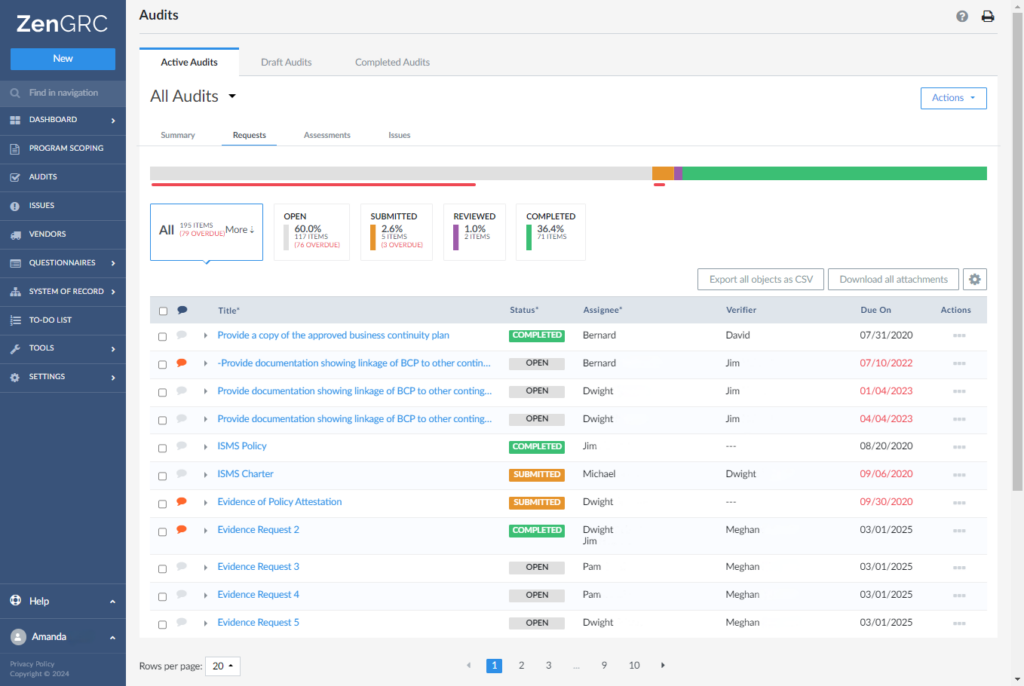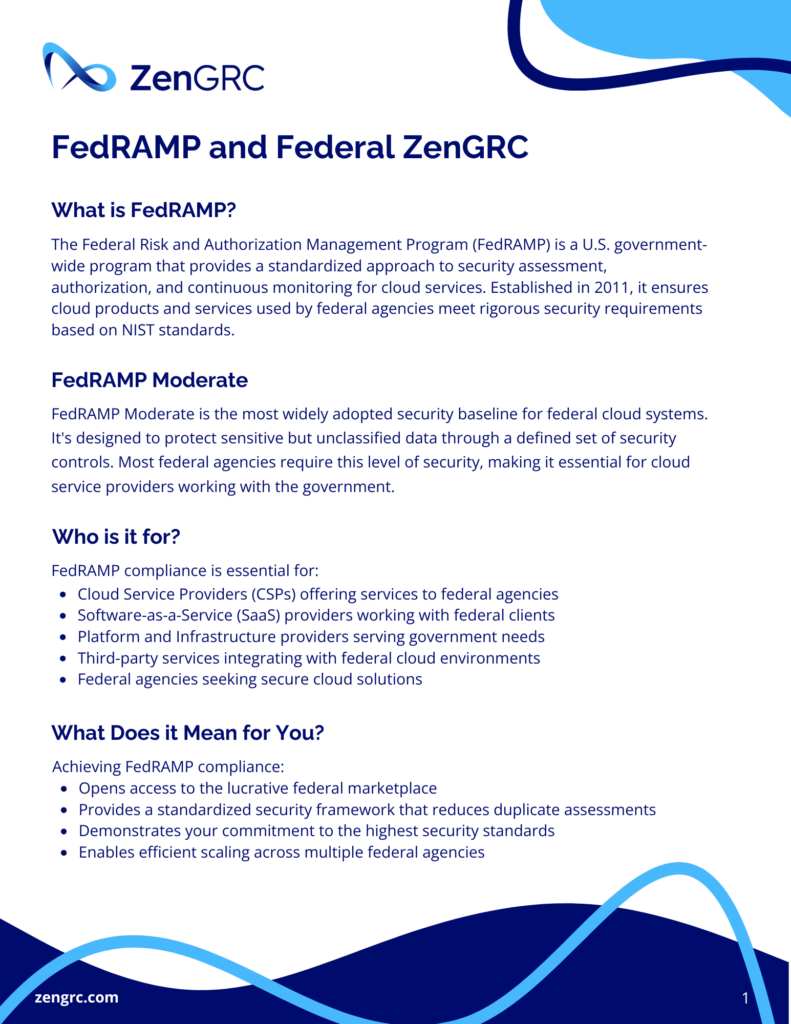FedRAMP Compliance Software
What is FedRAMP Compliance?
The Federal Risk and Authorization Management Program (FedRAMP) is a U.S. government regulation that dictates a standardized approach for security assessment, authorization, and continuous monitoring of cloud products and services offered by cloud service providers (CSPs); these products and services are collectively referred to as Cloud Service Offerings (CSOs).
FedRAMP was introduced in 2011 as a memorandum to government agencies CIOs to improve the state of their information technology systems within the federal government. It encourages agencies to explore cloud computing options before they allocate financial resources to new infrastructure.
Prior to FedRAMP, every federal agency managed its own security assessments based on guidance provided by the Federal Information Security Management Act (FISMA). That resulted in a scattershot, indisciplined approach to assessing the security of CSPS. Before FedRAMP, each agency using a cloud product or service had to conduct a security assessment and issue an Authority to Operate (ATO), under FedRAMPan ATO can be inherited in full or part reducing the administrative burden and length of time to compliance when being acquired by a new agency.
FedRAMP affects both federal agencies, such as the Department of Defense (DoD) and the Department of Homeland Security (DHS); as well as CSPs. Federal Agencies are required to ensure their cloud products and services are FedRAMP compliant and CSPs are responsible for attaining and maintaining FedRAMP compliance for their products and services. FedRAMP authorization seeks to determine whether CSPs meet the appropriate federal cloud security guidelines.
To qualify, CSPs must be audited by a FedRAMP accredited third-party assessment organization (3PAO) to confirm whether they are FedRAMP-compliant.
Why is FedRAMP Compliance Important?
FedRAMP is important to U.S. government agencies because it simplifies the task of finding reliable, trustworthy cloud service providers and ensures compliance with FISMA.
For example, consider a public facing federal agency like the IRS that wants to upgrade its computer information systems to store citizen information in the cloud. Since those bills contain personally identifiable information (PII) and government data, the city will need to find a software-as-a-service program (SaaS) or platform-as-a-service (PaaS) that meets FedRAMP security standards.
FedRAMP is also important for CSPs because without a proper compliance program that meets and maintains ongoing compliance with FedRAMP standards, those CSPs run the risk of losing valuable business relationships with government agencies. They could also lose the trust of customers concerned about the protection of their personal information.
FedRAMP Requirements at a Glance
The foundation for FedRAMP guidelines is based on the National Institute of Standards and Technology (NIST) Special Publication 800-53, which sets forth guidelines for information security controls regarding cloud computing environments.
There are three security baseline levels of FedRAMP authorization:

These levels vary based on the different types of data that CSPs manage and the methods used to secure that data. The degree of severity (low, moderate, and high) refers to the potential impact that can occur should an information system be compromised.
FedRAMP Compliance Checklist
To help you get started with FedRAMP certification, we’ve also compiled this checklist from our guide to FedRAMP compliance:
| 1 | Create your System Security Plan (SSP) for all information security controls. |
| 2 | Implement continuous monitoring to pinpoint and remediate vulnerabilities as they occur. |
| 3 | Re-evaluate your security controls regularly to assure they are still effective at mitigating all cybersecurity risks. |
| 4 | Align employees, security officers, and government liaisons on your FedRAMP information system security program. |
| 5 | When submitting a Readiness Assessment Report (RAR), or an update, notify info@fedramp.gov to ensure review. |
| 6 | Use a 3PAO assessor to conduct your Security Assessment Plan (SAP) and/or Security Assessment Report (SAR). |
FedRAMP Moderate Compliance Made Easy with ZenGRC
ZenGRC simplifies the complex and often overwhelming process of FedRAMP Moderate documentation, security assessment, and reporting. With its integrated document management system, it automates the creation, storage, and retrieval of necessary documents, ensuring compliance records are always up to date and easily accessible.
- Automating FedRAMP Compliance Workflows: ZenGRC streamlines the government agencies’ FedRAMP Moderate compliance process by automating critical workflows including automatically tracking and managing tasks related to compliance activities, sending reminders for important deadlines, and facilitating the flow of information across teams..
- Reducing FedRAMP Certification Costs: Implementing ZenGRC can significantly reduce the costs associated with achieving and maintaining FedRAMP Moderate certification. By automating many aspects of the compliance process, it reduces the need for extensive manual effort and resource allocation.
- Real-time Metrics for FedRAMP Insights & Reports: ZenGRC provides real-time metrics and analytics, offering valuable insights into the FedRAMP Moderate compliance status. The ability to generate real-time reports provides clear and concise information that can be shared with external auditors and stakeholders, ensuring transparency and trust in the organization’s compliance status.
ZenGRC FedRAMP Moderate Capabilities
- User-friendly dashboard with real-time metrics on prioritized risks
- Pre-built templates that can help you to make compliance audits as cost-effective as possible
- A central repository for all audit-ready documentation
- Universal Control Mapping to streamline multiple requirements with a single control
- Insight into team member progress at fulfilling FedRAMP Moderate requirements
- Automation to track outstanding requirements for cloud service offerings

ZenGRC’s FedRAMP Moderate Ready solution and strategic
partnership with Steel Patriot Partners empowers federal agencies
and contractors to streamline their path to FedRAMP compliance.
Key Features of Effective FedRAMP Compliance Software
Proactive Real-time Monitoring for FedRAMP :
Proactive Real-time Monitoring is essential in FedRAMP compliance software, enabling CSPs to continuously monitor their networks and systems to detect security threats or compliance issues swiftly. This feature is fundamental for protecting federal data and ensuring quick risk management and response.
Centralized Log Management:
Centralized Log Management is crucial for FedRAMP compliance, offering a unified platform for collecting, storing, and analyzing logs within the cloud environment. It’s instrumental in auditing, tracking activities, and identifying security incidents, providing a detailed history for FedRAMP audits.
Efficient Incident Detection and Streamlined Response:
Efficient Incident Detection and Streamlined Response features are key for identifying and addressing security breaches or compliance deviations rapidly. These tools are vital for maintaining cloud security, minimizing damage, and ensuring continuous compliance with FedRAMP standards.
Detailed FedRAMP Compliance Reporting:
Detailed FedRAMP Compliance Reporting is vital for documenting adherence to each FedRAMP control. The software should facilitate customized reports for audits and reviews, streamlining the process and ensuring efficient and comprehensive compliance demonstration
Robust User and Access Management for FedRAMP :
Robust User and Access Management is fundamental in compliance software for controlling access to sensitive data and systems. It manages user identities, permissions, and roles, while monitoring resource access, crucial for preventing unauthorized access and enhancing security and accountability in line with FedRAMP requirements.
FAQs for FedRAMP Compliance
What companies need to be FedRAMP-certified?
To contract with government agencies under the umbrella of the FedRAMP marketplace, all cloud-based managed service providers must obtain FedRAMP certification.
What are the types of FedRAMP compliance?
FedRAMP grants cloud service providers (CSPs) and cloud service offerings (CSOs) to work with government agencies at three impact levels: low, moderate, and high. These levels refer to the sensitivity of the data the cloud provider is equipped to process, store, and transmit.
What is the difference between FedRAMP and ISO 27001?
The main difference between FedRAMP and ISO 27001 is that FedRAMP focuses on cloud service providers that seek to provide services to the U.S. government.
In contrast, ISO 27001 can apply to any business, in any industry, that has some obligation to obtain an independent assessment of its IT security management system.
Furthermore, ISO 27001 certification is issued for three years, whereas FedRAMP is based on assessing an organization’s security controls during a period in time.
How much does it cost to get FedRAMP certified?
Several factors go into FedRAMP certification cost. These include:
- The complexity of your cloud services.
- Whether you are seeking authorization from one agency or from the Joint Authorization Board (JAB), which serves multiple government agencies at once.
- Whether your risk severity is deemed low, moderate, or high.
- The size of the gap between your existing controls and documentation and what’s required for FedRAMP authorization.
- The resources you have available to prepare for the FedRAMP authorization process.
With all these factors, it is safe to assume that FedRAMP authorization costs can range from $75,000 to $3.5 million.
Is Office 365 FedRAMP compliant?
Yes, Microsoft Office 365 has been given FedRAMP security authorization.
Is Amazon Web Services (AWS) FedRAMP compliant?
Yes, Amazon has announced that AWS GovCloud (US) has received a Provisional Authority to Operate (P-ATO) from the JAB under FedRAMP with a “high” baseline.
What are common challenges to achieving FedRAMP compliance?
Achieving FedRAMP compliance can be a complex and demanding process for cloud service providers (CSPs) looking to work with U.S. federal agencies. Some of the most common hurdles include:
- Understanding the Requirements: FedRAMP has a comprehensive and detailed set of requirements that can be overwhelming. CSPs must fully understand these requirements, which can be a significant challenge, especially for new entrants. Complete a readiness assessment to familiarize yourself with the requirements and how to fulfill them.
- Resource Allocation: The process requires substantial investment in terms of time, personnel, and finances. Small to medium-sized companies may find it particularly challenging to allocate the necessary resources as part of a system security plan and security package.
- Technical Challenges: Implementing the required security controls and ensuring continuous compliance with FedRAMP standards often involves overhauling existing systems, which can be technically complex.
- Documentation and Evidence: Comprehensive documentation is a critical part of the FedRAMP authorization process. Preparing and maintaining this documentation, which includes policies, procedures, and evidence of compliance, can be daunting.
- Continuous Monitoring and Updates: FedRAMP compliance is not a one-time event but an ongoing process. CSPs must continuously monitor their systems and update their security measures to stay compliant undergoing audits conducted by assessors with agency authorization regularly.
How to overcome FedRAMP compliance challenges?
Overcoming these hurdles requires a strategic approach:
- Expert Guidance and Training: Engaging with FedRAMP experts or consultants and providing thorough training to staff can help in better understanding and navigating the FedRAMP requirements for your information systems.
- Strategic Planning and Investment: Develop a strategic plan for resource allocation. This includes budgeting for the costs of compliance and investing in the necessary personnel and technology.
- Leveraging Automation: Utilize automated tools for continuous monitoring and compliance management. Automation can significantly reduce the workload and help maintain compliance more efficiently.
- Thorough Documentation Practices: Establish robust documentation practices. This not only helps in achieving compliance but also simplifies the process of maintaining and updating necessary records.
- Staying Informed and Agile: Keep abreast of changes in FedRAMP standards and guidelines. An agile approach to compliance can help in adapting quickly to any updates in the requirements.
By understanding these challenges and implementing strategies to overcome them, CSPs can navigate the FedRAMP compliance process more effectively, opening doors to valuable opportunities in the federal market.
